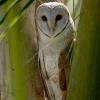A medium-sized, heavily-streaked buff, terrestrial owl with long wings. Upperparts and breast streaked blackish on buff ground colour. Upper primaries
are yellowish with black tips and white trailing edge. Under-wing whitish with black tips and carpal crescents. A small head with short ear tufts and bold facial disc; black mask round small yellow irises. Cat-like face. Sexes alike. Diurnal hunter covering ground buoyantly. Rests in grass clumps or in shade of thorn
bush. If flushed often flies high when may be mobbed by raptors or corvids. Will perch on posts.
- Browse
- Gallery
- Checklists
- Topography
- Glossary
- Bibliography
- Feedback
- About Us










